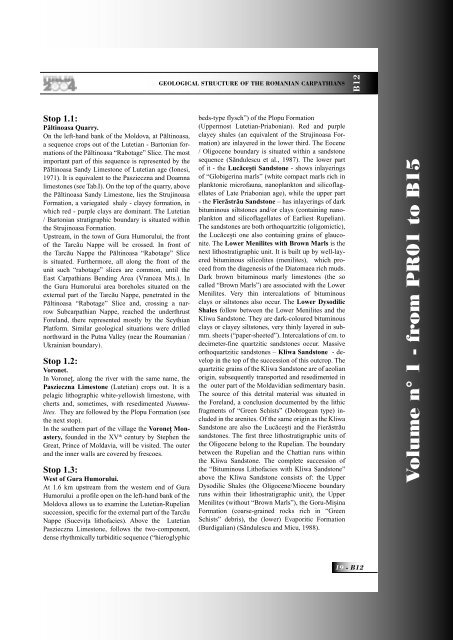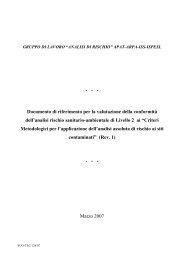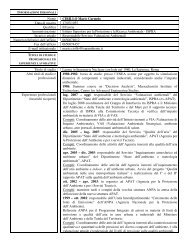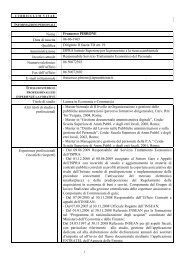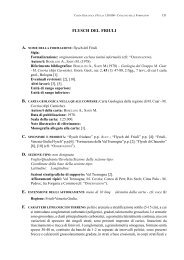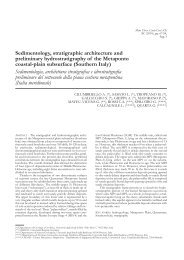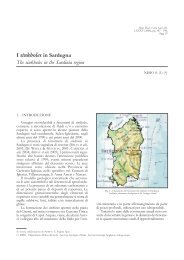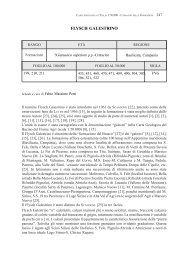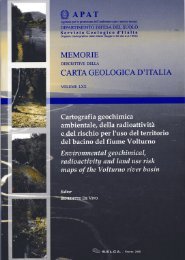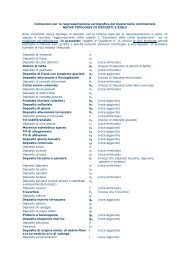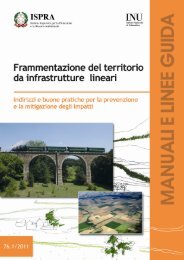Guidebook - Ispra
Guidebook - Ispra
Guidebook - Ispra
You also want an ePaper? Increase the reach of your titles
YUMPU automatically turns print PDFs into web optimized ePapers that Google loves.
Stop 1.1:<br />
Păltinoasa Quarry.<br />
On the left-hand bank of the Moldova, at Păltinoasa,<br />
a sequence crops out of the Lutetian - Bartonian formations<br />
of the Păltinoasa “Rabotage” Slice. The most<br />
important part of this sequence is represented by the<br />
Păltinoasa Sandy Limestone of Lutetian age (Ionesi,<br />
1971). It is equivalent to the Paszieczna and Doamna<br />
limestones (see Tab.I). On the top of the quarry, above<br />
the Păltinoasa Sandy Limestone, lies the Strujinoasa<br />
Formation, a variegated shaly - clayey formation, in<br />
which red - purple clays are dominant. The Lutetian<br />
/ Bartonian stratigraphic boundary is situated within<br />
the Strujinoasa Formation.<br />
Upstream, in the town of Gura Humorului, the front<br />
of the Tarcău Nappe will be crossed. In front of<br />
the Tarcău Nappe the Păltinoasa “Rabotage” Slice<br />
is situated. Furthermore, all along the front of the<br />
unit such “rabotage” slices are common, until the<br />
East Carpathians Bending Area (Vrancea Mts.). In<br />
the Gura Humorului area boreholes situated on the<br />
external part of the Tarcău Nappe, penetrated in the<br />
Păltinoasa “Rabotage” Slice and, crossing a narrow<br />
Subcarpathian Nappe, reached the underthrust<br />
Foreland, there represented mostly by the Scythian<br />
Platform. Similar geological situations were drilled<br />
northward in the Putna Valley (near the Roumanian /<br />
Ukrainian boundary).<br />
Stop 1.2:<br />
Voronet.<br />
In Voroneţ, along the river with the same name, the<br />
Paszieczna Limestone (Lutetian) crops out. It is a<br />
pelagic lithographic white-yellowish limestone, with<br />
cherts and, sometimes, with resedimented Nummulites.<br />
They are followed by the Plopu Formation (see<br />
the next stop).<br />
In the southern part of the village the Voroneţ Monastery,<br />
founded in the XV th century by Stephen the<br />
Great, Prince of Moldavia, will be visited. The outer<br />
and the inner walls are covered by frescoes.<br />
Stop 1.3:<br />
West of Gura Humorului.<br />
At 1.6 km upstream from the western end of Gura<br />
Humorului a profile open on the left-hand bank of the<br />
Moldova allows us to examine the Lutetian-Rupelian<br />
succession, specific for the external part of the Tarcău<br />
Nappe (Suceviţa lithofacies). Above the Lutetian<br />
Paszieczna Limestone, follows the two-component,<br />
dense rhythmically turbiditic sequence (“hieroglyphic<br />
GEOLOGICAL STRUCTURE OF THE ROMANIAN CARPATHIANS<br />
beds-type flysch”) of the Plopu Formation<br />
(Uppermost Lutetian-Priabonian). Red and purple<br />
clayey shales (an equivalent of the Strujinoasa Formation)<br />
are inlayered in the lower third. The Eocene<br />
/ Oligocene boundary is situated within a sandstone<br />
sequence (Săndulescu et al., 1987). The lower part<br />
of it - the Lucăcești Sandstone - shows inlayerings<br />
of “Globigerina marls” (white compact marls rich in<br />
planktonic microfauna, nanoplankton and silicoflagellates<br />
of Late Priabonian age), while the upper part<br />
- the Fierăstrău Sandstone – has inlayerings of dark<br />
bituminous siltstones and/or clays (containing nanoplankton<br />
and silicoflagellates of Earliest Rupelian).<br />
The sandstones are both orthoquartzitic (oligomictic),<br />
the Lucăcești one also containing grains of glauconite.<br />
The Lower Menilites with Brown Marls is the<br />
next lithostratigraphic unit. It is built up by well-layered<br />
bituminous silicolites (menilites), which proceed<br />
from the diagenesis of the Diatomaea rich muds.<br />
Dark brown bituminous marly limestones (the so<br />
called “Brown Marls”) are associated with the Lower<br />
Menilites. Very thin intercalations of bituminous<br />
clays or siltstones also occur. The Lower Dysodilic<br />
Shales follow between the Lower Menilites and the<br />
Kliwa Sandstone. They are dark-coloured bituminous<br />
clays or clayey siltstones, very thinly layered in submm.<br />
sheets (“paper-sheeted”). Intercalations of cm. to<br />
decimeter-fine quartzitic sandstones occur. Massive<br />
orthoquartzitic sandstones – Kliwa Sandstone - develop<br />
in the top of the succession of this outcrop. The<br />
quartzitic grains of the Kliwa Sandstone are of aeolian<br />
origin, subsequently transported and resedimented in<br />
the outer part of the Moldavidian sedimentary basin.<br />
The source of this detrital material was situated in<br />
the Foreland, a conclusion documented by the lithic<br />
fragments of “Green Schists” (Dobrogean type) included<br />
in the arenites. Of the same origin as the Kliwa<br />
Sandstone are also the Lucăcești and the Fierăstrău<br />
sandstones. The first three lithostratigraphic units of<br />
the Oligocene belong to the Rupelian. The boundary<br />
between the Rupelian and the Chattian runs within<br />
the Kliwa Sandstone. The complete succession of<br />
the “Bituminous Lithofacies with Kliwa Sandstone”<br />
above the Kliwa Sandstone consists of: the Upper<br />
Dysodilic Shales (the Oligocene/Miocene boundary<br />
runs within their lithostratigraphic unit), the Upper<br />
Menilites (without “Brown Marls”), the Goru-Mișina<br />
Formation (coarse-grained rocks rich in “Green<br />
Schists” debris), the (lower) Evaporitic Formation<br />
(Burdigalian) (Săndulescu and Micu, 1988).<br />
B12<br />
19 - B12<br />
Volume n° 1 - from PR01 to B15


